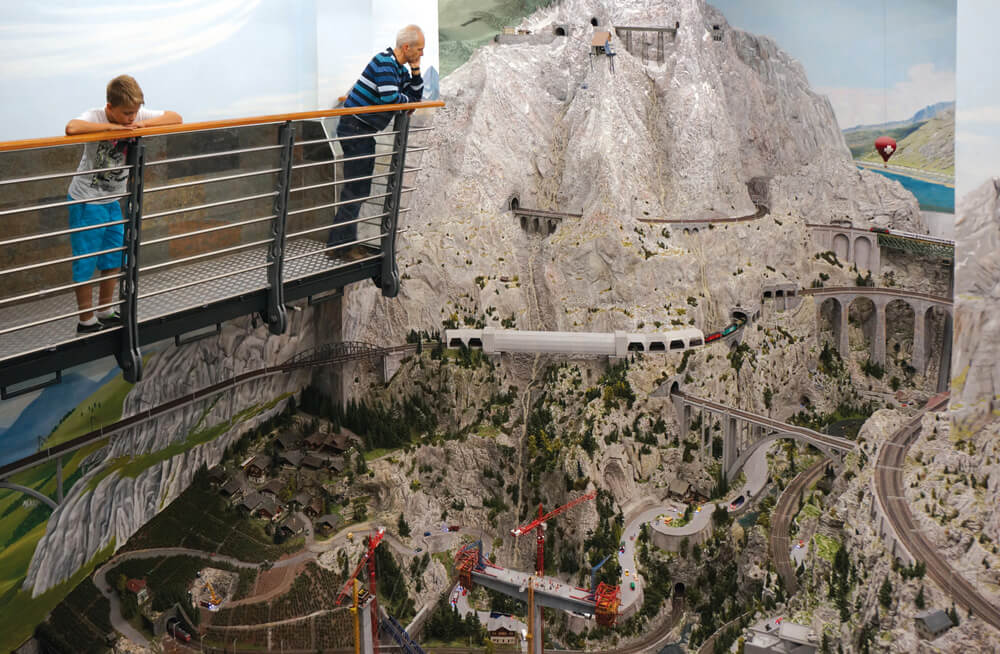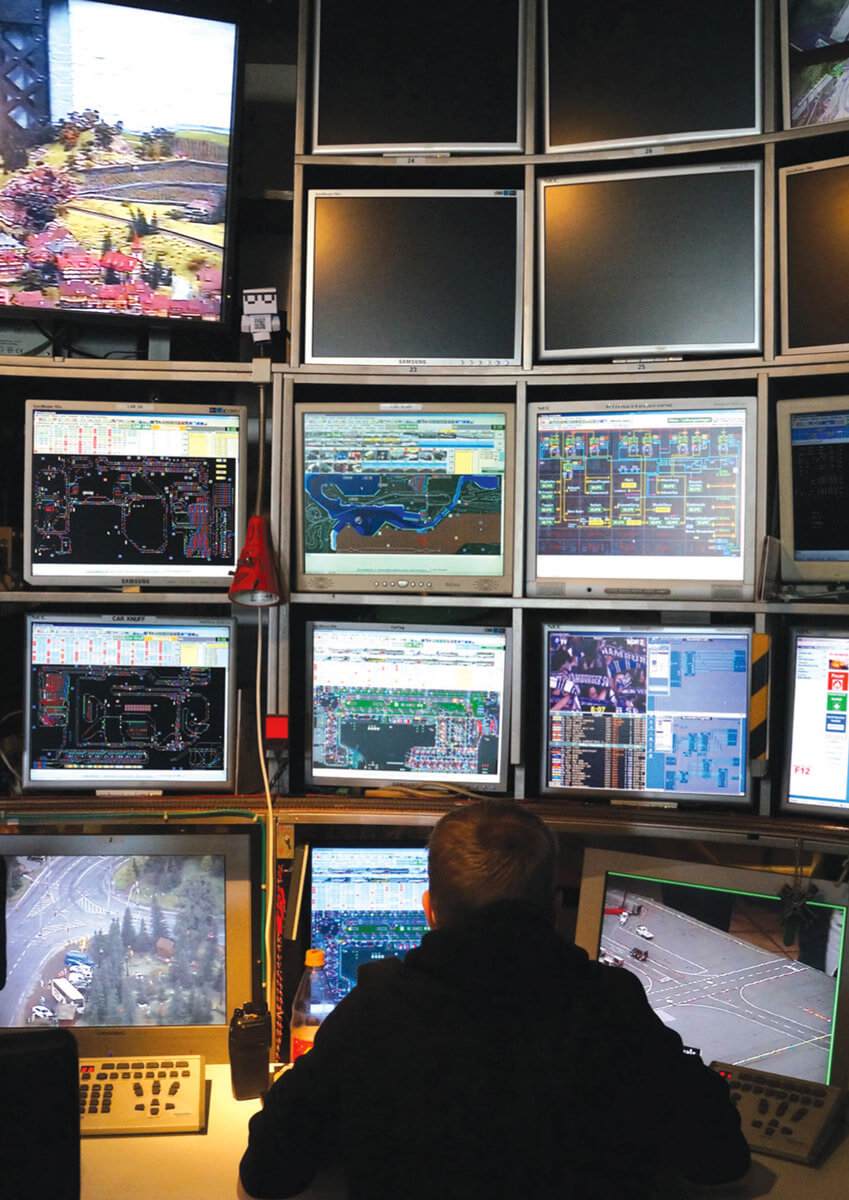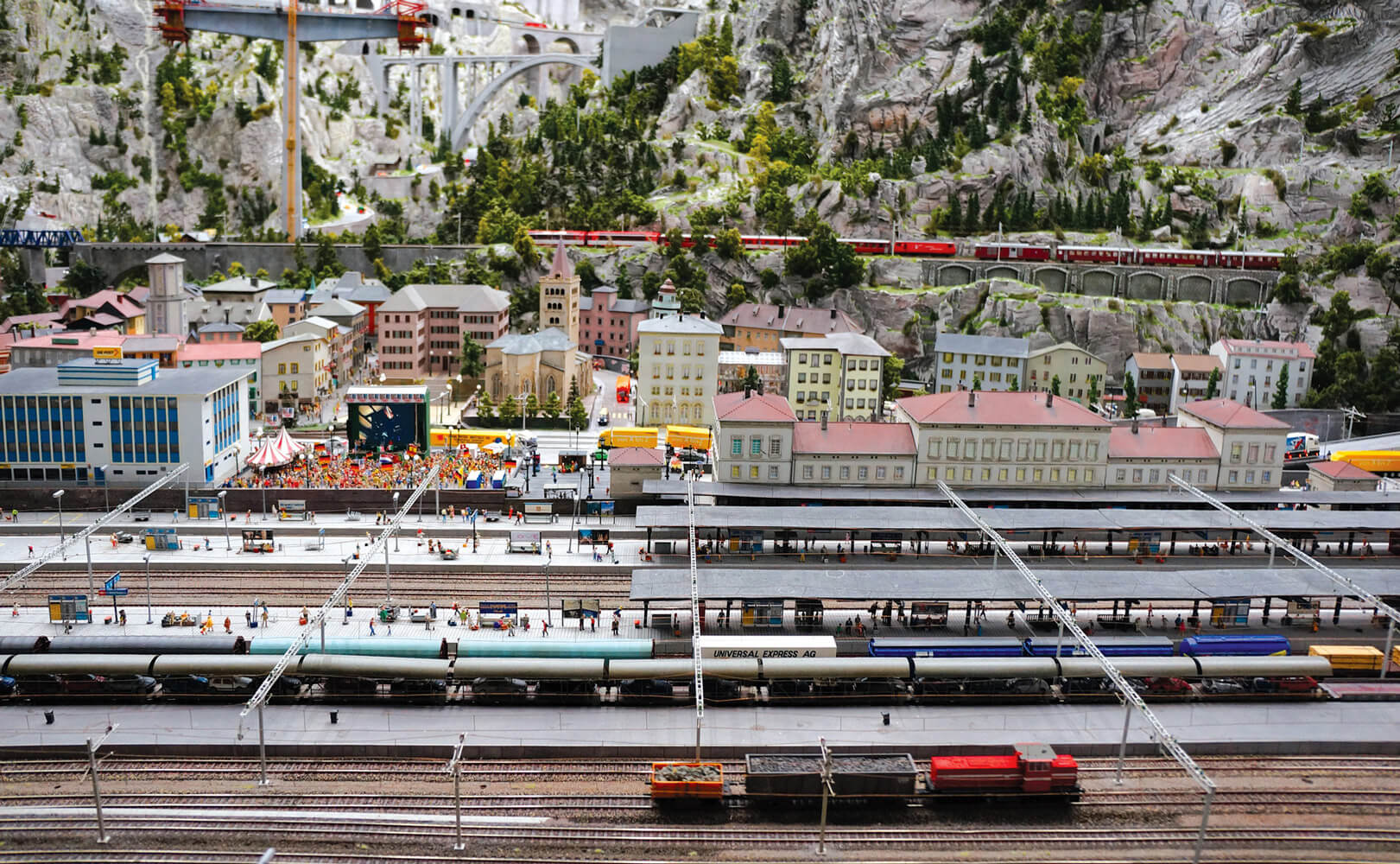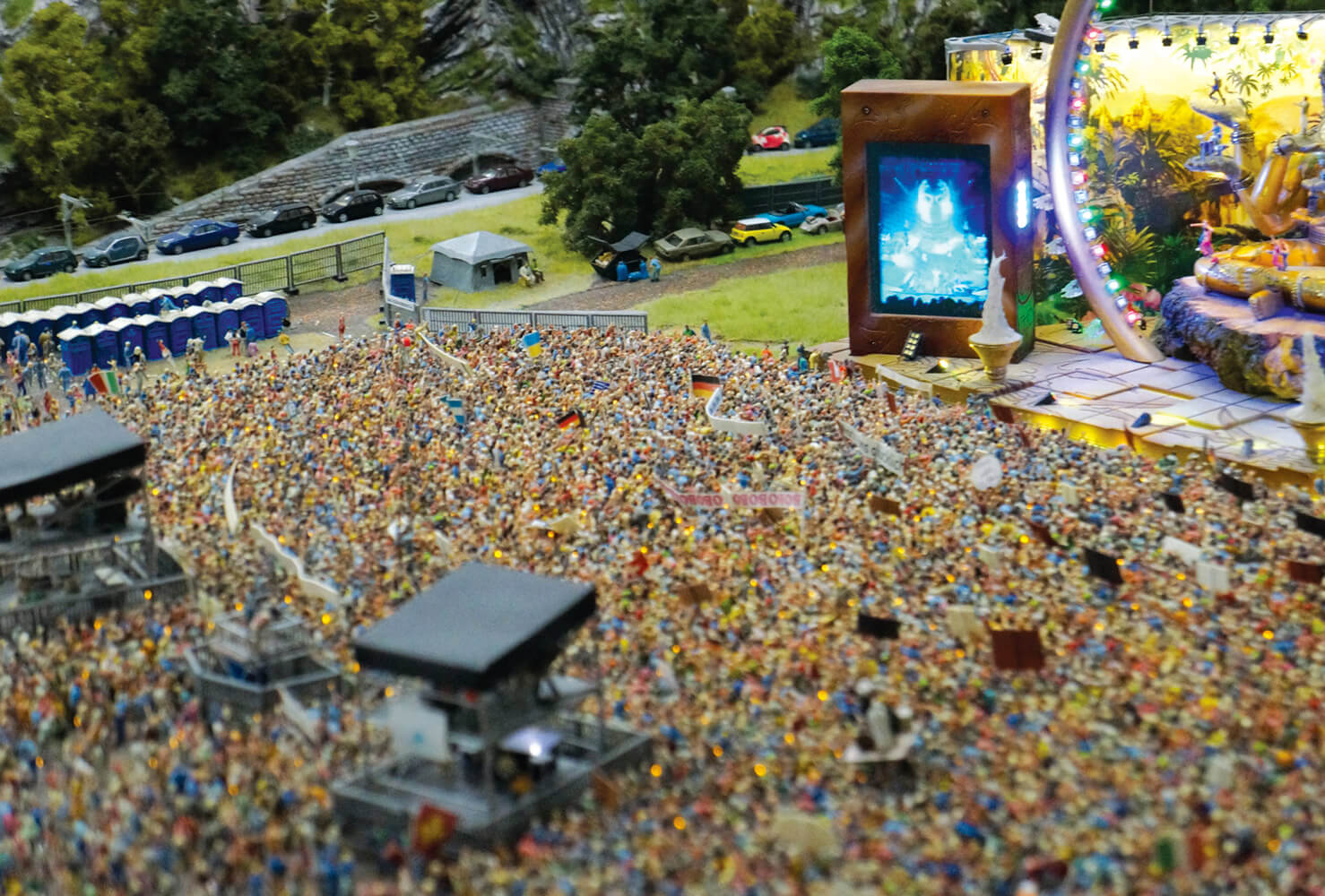A Model Railway Journey
Inside Hamburg’s Miniatur Wunderland
Ava Kofman

As with so many aspirations to totality, the world’s largest miniature railway was fueled by colossal, quixotic ambitions. In 2000, a nightclub owner by the name of Frederik Braun visited a model train shop in Zurich when, as he tells it, he started to dream. He dreamt of building the largest model railway the world had ever seen. He called his twin brother and business partner, Gerrit, “who is more rational and skeptical by nature,” and tried to convince him that his idea wasn’t insane. Eventually, he succeeded. And, as in a fairy tale, a few years and tens of thousands of dollars later, a team of engineers helped make their dream come true.
In 2003, along the banks of the Elbe River where it snakes through downtown Hamburg, the Miniatur Wunderland was born. Housed in a repurposed warehouse, it is a sprawling reproduction of elements of the world’s geography, connected by nearly ten miles of intricate built-to-scale railway tracks, which lengthen with each passing year. The constituent parts are tiny, but the Wunderland’s scale staggers: over 200,000 individually designed human figurines, 930 trains, 8,850 cars and ships, 215,000 trees, 300 people-sized employees, and millions of annual visitors from around the world.
I first learned of Hamburg’s most popular tourist attraction from its promotional trailer on YouTube, which has over twenty million views. A clipped, German-accented voice tells of the Wunderland’s numerological marvels with unselfconsciously comic exactitude. It describes how its replicas of Scandinavia, Germany, Switzerland, and parts of the United States will soon be joined by “parts of Africa.” Adopting the rhetoric of a conquering empire, it boasts that the Miniatur Wunderland is always expanding.
What was it, I wondered, as I watched aerial shots of tiny shimmering cities, tiny airports, tiny humans making love in a field of tiny sunflowers, that would lead someone to build such a gigantic small world? Was it just my imagination or was there something about the Wunderland’s suggestion of infinity, its potential to expand and swallow the real world, that echoed Germany’s own imperial, industrial, and military histories?
Not long after, I booked a flight, a train, and a ferry to Hamburg. I went to the Wunderland expecting to find a metaphor both less and more than the sum of its improbably numerous parts, its machinery caught between a positivist dream and a totalitarian nightmare. But what I discovered was not so much a Gesamtkunstwerk as a protean work-in-progress, a workshop suffused with a model train enthusiast’s sense of wonder.
When Frederik returned to Hamburg, the brothers began to discuss what a miniature train world might look like. They knew of at least ten model train set exhibitions in Germany alone. Featuring trains as the main attraction, with the surrounding landscape serving as background, they were of little interest to anyone who was not already a die-hard train hobbyist.
Considering what their competitors lacked, the twins began to list what they might put in their new world and quickly realized that 90 percent of their ideas had nothing to do with trains at all. They fantasized about building a mini–mini golf course, a massive music festival, the Eiffel Tower, the Eiffel Tower of Las Vegas, a chocolate factory. What most excited them was the act of miniaturization—its technical challenges, its inherent comedy, its demiurgic allure. They wanted to build a world where some people came for the trains, but everyone stayed for the scenery. It would be “a small world in front” for tourists and families, “with trains in the back” for model railway enthusiasts.
But even with these populist goals, they were nervous: the demographics of model railway enthusiasts skew very elderly, very male; they worried that women might not respond to the attraction, that teenagers might be bored. One of their solutions was the name Miniatur Wunderland, which, by not referencing trains, allowed them greater creative freedom. Gerrit told me that whenever train enthusiasts point out historical inaccuracies in a given layout, he replies, “It’s a Wunderland.” “Wunder” lets the twins sidestep the realist constraints of model railroading. It has also made their enterprise immensely popular.

Sebastian Dreschler, a younger half-brother of the twins and the Wunderland’s head of communications, described the Wunderland’s vast, two-story layout as a “huge playground.” And as he gave me a tour, I started to see what he meant. Quirky details and inside jokes fill every inch of the display: a Coca-Cola bear dances on an iceberg in Sweden; the German soccer team always wins its animatronic match; cars follow traffic rules; a gas station adjusts its prices for inflation; a mob boss hides a dead body in one of many forests; over twenty thousand figurines attend a music festival complete with a rotating cast of tiny performers. In Borgesian fashion, there’s even a scale replica of the Miniatur Wunderland itself. If you push a button, a miniature miniature train circles a tiny track.

Frederik and Gerrit’s fundamental insight, in reversing the foreground and background, was to extend the panoramic perspective afforded by model train sets to the objects of the world. At such a scale, Sebastian says, there is “enough space to think and to play,” even to fantasize about smaller-than-life solutions to real-world problems. When I visited in the fall of 2014, Hamburg’s new concert hall, the Elbharmonie, was closed to the public due to construction delays. But the Wunderland’s own Elbharmonie was very much open, so much so that Frederik and Gerrit hosted the city’s philharmonic orchestra for a live concert, which they synced with the movements of the miniature musicians.

Gerrit sees the Wunderland as a makeshift refuge for the many who make the pilgrimage. “They can leave all [their] problems behind,” he said, “and can dream.” Nearly eight hundred visitors have annual membership cards and visit multiple times a year. One man has visited every Tuesday for the past nine years, adhering to his own internal train schedule. Another spent three days traveling from Tokyo to immerse himself in the exhibition. Gerrit told me he never anticipated all of the fan mail, or the amount of visitors who seemed to be “enthusiasts, not tourists.”
Sebastian said he initially thought of model trains as a “stupid, dusty hobby,” not an attraction that would draw nearly two million visitors. He couldn’t believe that “a woman from New York”—he gestured to me—would come to see it for three days. In his view, part of the Wunderland’s appeal is that it appears less like a business and more like a collective participatory dream. “People don’t usually ‘throw it all in’ in Germany,” he said, referring to his brothers’ decision to turn the whimsical project their into life’s work. According to him, visitors to the Wunderland are not just buying into the delight that comes from gazing upon its meticulously engineered vistas; they are also enchanted by the “do what you love” ethos evoked by its founding myth.
When I asked Sebastian when the Wunderland’s construction would be over, he laughed. “It will never be finished.”

At the very least, the railway provided both young and old with a sensory education. It shrunk vast distances into mere seconds—what Marx famously called “the annihilation of space by time.” Travelers now found themselves in a miniaturized world. “The Mediterranean, which is now only a week from us, has before our eyes shrunk into a lake,” exclaimed an article in the 1839 Quarterly Review, “and the great lakes of the world are rapidly drying into ponds!”
Even as it destroyed the distance between towns, the railroad also opened up a greater amount of space than had ever before been accessible. The German poet Heinrich Heine captured this sense when he wrote, “I feel as if the mountains and the forests of all countries were advancing on Paris.” Distant towns, cities, and countries were no longer worlds apart. Now, in the words of the great railway historian Wolfgang Schivelbusch, you could travel between them “untouched by the space traversed.”
To accomplish this spatial reconfiguration, the railroad needed to make space regular. Because tracks needed to be constructed on certain gradients, and were intensely sensitive to the exigencies of topography, the rails had to reshape the land according to their needs. No wonder one fin de siècle writer described traveling by train as “really being nowhere.” Speeding through this newly flattened countryside on smooth rails was a far cry from taking a rambling walk or making a sweaty journey by horse. Impressions flew by quickly, and were often lost. Tunnels and telegraph poles interrupted views of the landscape so that it was perceived less as a vista than as a moving background. Ralph Waldo Emerson described the passing towns he encountered during his “dreamlike travelling on the railroad” as “pictures on a wall.” The train car was a sort of theater, its images overlapping in quick succession as in an early filmic montage.
It is no accident, according to Schivelbusch, that the mobile, roaming gaze enabled by the railway emerged alongside both the panorama, the late nineteenth century’s dominant visual attraction, and the department store, its mass incarnation. “In panoramic perception,” Schivelbusch writes, “the objects were attractive in their state of dispersal.” Seen from a railway car, the landscape could no longer be evaluated in terms of particular local features, such as a village, a mountain, or a church. Aesthetic appeal was based, instead, on the sum of these fleeting impressions.

As with a full-sized railway, the pleasure of gazing at the Wunderland’s shrunken, swollen universe depends less on appreciating any given miniature scene in isolation than it does on experiencing the sweep of its rolling landscapes. Like a department store, its novelty lies in its impressive assemblage and circulation of heterogeneous parts. The Wunderland tourist is constantly in motion, soaking up the details of the layout’s particulars. Yet when her eye rests for too long on any given particular, she is spurred back into motion by the system’s circulation, by the approach of a train or the push of someone in the crowd angling for a better view.
As we toured an Italian landscape then under construction, Sebastian told me that people visited the Wunderland for the same reason they went to the Empire State Building. “From above,” he said, “you can dream about the world.”

These are the same questions facing the Wunderland’s designers. In their heroic quest for a signature type of realism, they, too, weigh abstraction and accuracy. Choosing the materials, the colors, the scale—these are the easy decisions. Then there are the questions that are not simply practical, but ideological: Which of a nation’s features and landmarks should be considered? What criteria (popularity, proximity, and so on) should determine their inclusion? What type of realism is at stake? Whose point of view is this, anyway?

Frederik tells me that they initially developed the exhibition as a pure fantasy. The first section of the layout, Knuffingen, was a fictional German town, an everywhere that is nowhere in particular. He explained that later sections, inspired by specific locations, attempted to evoke recognizable tropes. At one point, the Swiss embassy complained that their section of the layout was “all stereotype.” But it would be more accurate to say that the entire Wunderland is itself a stereotype of a stereotype, dull in its reproduction of well-worn touristic desires, though occasionally brilliant in its descriptive precision.
When planning the Italy layout, the entire construction team traveled to the Amalfi coast for a week. They took numerous pictures of the dramatic cliffs, in an effort to reproduce the fine textures of the rocks. “Never before, we had to squeeze so much history into such close quarters,” reads a press release for the new Italy layout, in a slightly off-kilter English translation. But “history” might be a generous term for describing what the Wunderland’s realism includes.
Although many people are interested in the Wunderland in spite of its railways, the attraction’s aesthetics remain a testament to the railway enthusiast’s ingenuity. In order to incorporate its own mechanics into its spectacle, the Wunderland shows you both the view from above—peaceful, serene, perfect—as well as the view from below: the ongoing labor of its construction, its hidden tracks and wires. Glass panels along the sides of mountains reveal the layers of wood, wiring, and plaster beneath the layout. Through a large window, visitors can watch technicians and artists as they work on new regions of the model. The craftsman, too, becomes part of the small world.
By far the most enthusiastic of the Wunderland’s motley crew was Andy Uhl. Uhl starred in the videos on the company’s prolific YouTube channel, which has nearly eighty thousand subscribers and a horde of international fans who comment constantly. While some of the videos are fictional narratives, most showcase the Wunderland’s obsessive attention to technical detail, geographic realism, and troubleshooting. Even in its promotional videos, the Wunderland reveals both its photogenic surfaces and behind-the-scenes calculations.
Sebastian explained that the Wunderland’s trick perspectives comprise “the sum of so many different views and more than five hundred hands, which together create the real view.” Unlike Disneyland, which makes a point of hiding its craft in the service of magic, the Wunderland is all about pulling back the curtain, displaying its labor of love.
By far the strangest of these many “reveals” is the Wunderland’s control room, which serves as the routing system for the hundreds of trains. An array of Tron-like screens beams their coming and goings. Wunderland workers watch the displays and push buttons, ostensibly to help things along. But when I first saw the control room featured in the promotional trailer, a part of me wondered if it was just for show: a simulacrum of control, its buttons leading nowhere. In retrospect, I wonder if the control room was, in its aspirations to real-world power, a sort of life-sized miniature. The room appears as a throwback to a Cold War bunker, a fantasy of (small) world domination.
Gerrit said that he built a larger control room than was originally needed, anticipating that the Wunderland would expand. He bet correctly—both in terms of the expansion of its own world and its expansion into ours. “There are only six countries left from which we had no visitors so far,” one press release maintains. “We hope to erase one or the other blank spot on the map in 2014.”
Of course, the logic of the toy train has incorporated the possibility for infinite expansion from its beginnings. Some of the earliest locomotive models were built as marketing materials for railways, perhaps in the hope that miniaturizing these giant machines would make them more palatable to the masses. When the first mass-produced toy train set was launched by the German firm Marklin in 1891, the company introduced a series of standard parts, so that children and adults could expand their starter sets indefinitely. This iterative marketing scheme created an insatiable imperial desire in rich and poor consumers alike, both of whom could satisfy their needs at different price points and sizes. For Marklin, it created a constant revenue stream.

Unsurprisingly, groups from around the world, including Qatar, Dubai, Japan, Korea, and New York City, have offered Fredrik and Gerrit large sums to build them Wunderlands. But the brothers have all emphasized their commitment to their hometown. Though knockoffs have opened in the past year, none have achieved anything close to the Wunderland’s level of success. “Our success is known all over the world,” Fredrik stated. “It’s really good for Hamburg.” Sebastian explained that if they stay (relatively) small then they can’t be “accused of being a business, of being in it for something other than craftsmanship and joy and fun.” Passion, not business. Wonder, not trains.
• • •
At the end of my first day at the Wunderland, I took a walk along the placid Elbe, wondering how the experience of the attraction would affect my experience of moving through the world beyond its multi-story realm. All at once I felt—or, maybe, was trying to make myself feel—as though I was becoming more observant of everyday details. A man talking to himself. A stray dog peeing into the water. A bride and groom snapping wedding photos on one of the river’s many bridges. Cranes like matchsticks in the harbor. Like latter-day Balzacs, the model-makers collect moments like these from the city, and bind them together with a mathematical understanding of realism as the sum of many small parts.
The next day, when I returned to the Wunderland, televisions in the cafeteria and waiting room were already playing an Ice Bucket Challenge video that the staff had filmed just days earlier. The Wunderland, I realized, was not just a static model city but a vast multimedia apparatus—digesting, remixing, and replaying its own parts. Even the waiting room was well stocked with glossy books detailing the Wunderland’s colorful history in multiple languages. In this light, the Wunderland’s partnership with Google Maps to produce thousands of panoramic “Street View” images of the layout is just its latest ingenious publicity stunt.
A titanic mythmaking operation, the Wunderland sells the promise that at the right scale, all of your dreams can come true. It’s a tempting fantasy, especially in a time of widespread austerity. One model-builder constructed his dream house in Norway, on the far end of the Scandinavia layout. On the front porch, he placed a little model of himself, enjoying the view.
Ava Kofman is a writer based in Brooklyn. Her work has appeared in the Atlantic, the Nation, the New Republic, and elsewhere. She is on the editorial staff of Harper’s Magazine.
Spotted an error? Email us at corrections at cabinetmagazine dot org.
If you’ve enjoyed the free articles that we offer on our site, please consider subscribing to our nonprofit magazine. You get twelve online issues and unlimited access to all our archives.